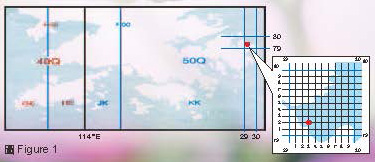 Leisure and Cultural Services Department - Healthy Exercise for All Campaign – Hiking SchemeLeisure and Cultural Services Department
Leisure and Cultural Services Department - Healthy Exercise for All Campaign – Hiking SchemeLeisure and Cultural Services Department
Know Your Map
Use a countryside map
Hikers are advised to use the Countryside Maps in 1:25000 scale published by the Lands Department. The series comprises five sheets entitled “Hong Kong Island & Neighbouring Islands”, “Lantau Island & Neighbouring Islands”, “North West New Territories”, “North East & Central New Territories” and “Sai Kung & Clear Water Bay”.
Grid reference on a map
- Knowledge of the Grid Reference System helps hikers pinpoint and record locations on a map in a quick, precise and systematic manner.
- A grid reference is formed by combining the numbers of the easting and the northing. A 4-digit grid reference is used for general mapping purpose. For example, to locate “KK 29 79-Sai Wan, Sai Kung”, hikers should first find the easting numbered “29”, and then the northing numbered “79”. The interception of these two lines is at the bottom left corner of a 1 000 square metre section, in which Sai Wan, Sai Kung is located. For a more precise indication, a 6-digit grid reference is used to pinpoint a position within a section that measures 100 square metres. For example, the grid reference “KK 293792” is used to indicate the location of Sai Wan Pier, Sai Kung. (See Figure 1)
- The Agriculture, Fisheries and Conservation Department has erected distance posts at intervals of 500 meters along major long-distance hiking trails (including the MacLehose Trail, the Wilson Trail, the Lantau Trail and the Hong Kong Trail) for hikers to identify their location. In case of emergency, hikers can report their position by referring to the grid reference on the nearest distance post so as to facilitate search and rescue operations.

Colours used on a map
- Green indicates woods, grassland, farmland, etc.
- Blue indicates river, pond, reservoir, sea, etc.
- Brown indicates buildings, beaches, mudflats, gravelled lands, contour lines, etc.
- Red indicates hiking trails (including family trails, nature trails, country trails and long-distance hiking trails).
- Orange indicates footpaths.
- Black indicates roads, expressways, bridges, railways, overhead power lines, etc.
Contour lines on a map
- Contour lines are used to show the landforms.
- The farther apart the contour lines are, the flatter the terrain is. On the contrary, packed lines forming irregular patterns represent steep slopes.
- A bundle of lines that overlap or nearly overlap with one another indicate a cliff.
- Tortuous and irregular contour lines represent rugged topography. Hikers should pay special attention to avoid getting lost.
